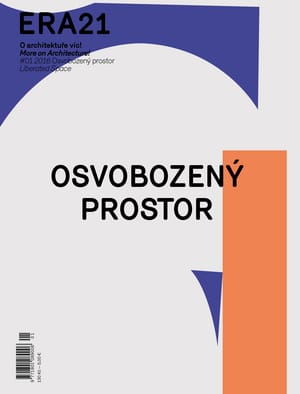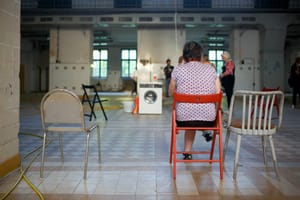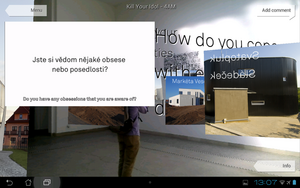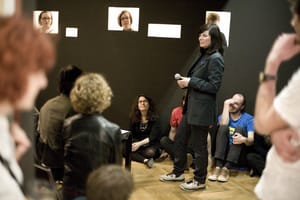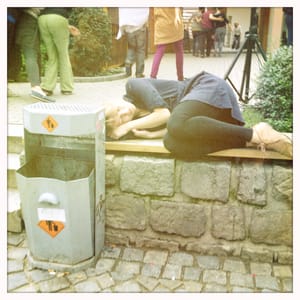- Born
- 1981
- Birth place
- Brno
- Place of work
- Brno
- Keywords
About theorist
Petra Hlaváčková is an art historian, curator, documentary maker and journalist whose output is strongly anchored in her interest in architecture, urbanism and feminism. However, these spheres are constantly intertwined in her work and overlap into other fields, above all sociology (gender studies), which has become an important feature not only of Hlaváčková’s research activities, but also in the conception and structure of the exhibitions she curates.
Hlaváčková completed her degree in art history at Masaryk University in Brno with a thesis on Karl Lehrmann, an architect working in the first half of the twentieth century. This work was a harbinger of her subsequent interest in the history of twentieth century architecture. She brought this interest to bear on the Brno Manual of Architecture, which charts new buildings created between 1918 and 1945. The project culminated in the publication of a guide to the architectural gems of Brno (2011) and an internet database, which has been extended to include post-war buildings (2019). Along with Rostislav Koryčánek, Šárka Svobodová and Lucie Valdhansová, Hlaváčková was a project initiator as well as coordinator and author of texts about individual works.
Feminist theory provides an important base for Hlaváčková’s work, and in her own research she constantly endeavours to link theory with practical applications. She reflects upon feminist perspectives within art theory and practice and, in addition to historical research (especially into the social history of art), she is interested in sociological connections. An example of this would be her contribution to the conference Feministická avantgarda (nejen) v česko-slovenských souvislostech / The Feminist Avant-Gardewithin (not only) the Czech and Slovak Context (2019) at the House of Arts in Brno, in which she outlined the everyday life of a female artist during the 1970s and 1980s in Czechoslovakia against the backdrop of questions pertaining to the emancipation of women. Hlaváčková is also an art critic who writes about exhibitions with a gender-based theme and examines the possible productive utilisation of feminist theory in the conception of individual exhibitions. (See Ne každá ženská výstava je feministická / Not Every Female Exhibition is Feminist and Feministická slepota české umělecké scény / The Feminist Blindness of the Czech Art Scene)
However, there is no strict dividing line between architecture and feminism in Hlaváčková’s research. For instance, as editor of a special issue of the magazine ERA 21Osvobozený prostor (01/2016) she examined their points of intersection and attempted to present the main problems in architecture and urban planning from the perspective of gender. This would include the structure of education and the organisation of institutions. Hlaváčková highlights the need for platforms allowing women to network and exchange knowledge, experience and ideas on problems relating to gender. The second basic group of questions she poses in the magazine referred to centres around a discussion of new approaches to urban and town planning. In this respect Hlaváčková is especially interested in the relationship between gender and the creation of public space, as well as in architectural projects based on sociological research that take into account the specific behaviour and needs of individual groups of the population. She believes greater numbers of women need to be included in the generation of town planning so that they are able to bring to bear their valuable, though often overlooked, experience with public space and movement around the urban environment. In this respect we also need to speak of the visibility of women and other groups in public space, both in the sense of their concrete, physical presence, but also in terms of their inclusion in the institutions shaping these spaces. An emphasis on visibility also has a clear political and activist dimension, in which architecture is now perceived as a tool for social change. One of the practical outcomes of these ideas is Hlaváčková’s activity as a consultant on gender mainstreaming, i.e. the attainment of gender equality, especially in the sphere of town planning.
Curation is also a substantial part of Hlaváčková’s work. The projects she has curated arose mainly as part of the 4AM Forum for Architecture and Media in Brno, which she co-founded with Šárka Svobodová and Barbora Šedivá. In 2011 and 2012 this organisation was the administrator of the Architecture Gallery in Brno, where Hlaváčková organised several large exhibitions with extensive accompanying programmes. The opening exhibition Revoltujíci lidé / Revolting People (2011) was followed by a series of exhibitions, discussions, lectures and workshops with the umbrella title Kompaktní město / Compact City (2011). The project examined contemporary architectural projects being realised in already existing city structures, in which an emphasis was placed on sensitivity to the previous layers of urban and architectural features. The exhibition stood out for its interactivity, collaboration and confrontation (the initial conception and installation in the gallery was open to the public from the very start), and this dynamic conception was intended to create the impression of an ongoing experiment reflecting the character of the development of modern cities. The following project, Zabij svého Fuchse / Kill Your Idol (Brno 2011, 13th Architecture Biennale in Venice 2012, Leipzig 2013), was another important event that offered an unusual look at the contemporary architecture scene in Brno through the figure of the architect Bohuslav Fuchs and his legacy. The exhibition narrative drew heavily on Freudian psychoanalysis and the testimony of selected Brno artists and their own reflections on their models and gurus, and was presented by means of videos and original installations. Psychoanalysis was also part of Hlaváčková’s later project situated in the Prádelna art centre in Bohnice psychiatric clinic and based on deeper research into and an analysis of this specific location (Psychoanalýza jednoho prostoru aneb sonda do podvědomí bývalé bohnické prádelny / The Psychoanalysis of a Single Space, or an Exploration of the Unconscious of the Former Bohnice Laundry Room, 2013).
It is clear from a description of her activities that Hlaváčková is not interested simply in the traditional presentation of artworks, but views the exhibition as part of a broader concept of research. Individual projects and outputs are conceived of more as considerations or ongoing analyses of a particular problem, with an emphasis played on interaction with the viewer and the stimulation of debate.
Hlaváčková has also made several documentary films (Když máš práci, máš všechno / Once You Have a Job, You Have Everything) and is a member of the film collective Guerilla.film. She has worked as editor of the art section of the cultural fortnightly magazine A2 and overseen issues devoted to women’s collectives and Islamic feminism. She is the initiator of the research workshop Move the City, which focuses on movement in and experience of the public space.
- Author of the annotation
- Viktória Beličáková
- Published
- 2019
CV
- Education, grants and scholarships
2016 – současnost Angewandte Universität ve Vídni – ateliér Art and Film (vedený prof. Thomasem Heisem) 2001–2007 Filozofická fakulta Masarykovy univerzity – obor Dějiny umění a Francouzský jazyk a literatura (Magisterské studium, diplomová práce: Architektonická tvorba Karla Lehrmanna) 2004 Studijní pobyt na Univerzitě Jean Moulin v Lyonu v rámci programu Erasmus 1992–2000 Taneční konzervatoř Brno Rezidence a stipendia květen–červenec 2018 Stipendium Mileny Jesenské pro novináře na Ústavu humanitních věd (IWM) ve Vídni Projekt: Přehodnocení feminismu: Genderová politika v Rakousku a Československu v 60. a 70. letech prosinec 2014 Rezidenční kurátorský pobyt v MuseumQuartier ve Vídni Projekt: Nevyužitý potenciál feministické umělecké teorie březen–červen 2012 Čtyřměsíční studijní pobyt na Angewandte Universität ve Vídni v rámci stipendia Aktion
- Experience
2018 – současnost Konzultantka a badatelka na volné noze, téma genderu ve vztahu k veřejnímu prostoru 2017 Editorka výtvarné sekce, magazín A2 kulturní čtrnáctideník 2015–2016 Redaktorka, časopis ERA21 2015 Specialistka na moderní architekturu, Metodické centrum moderní architektury v Brně 2011–2016 Vyučující, Seminář dějin umění Filozofické fakulty Masarykovy univerzity v Brně 2016 Seminář: Feministická teorie dějin umění II 2014 Seminář: Feministická teorie dějin umění 2014 Cvičení: Kurátorství jako výzkum 2013–2015 Cvičení: Reflexe brněnské poválečné architektury 2011–2015 Cvičení:Reflexe brněnské meziválečné architektury 2012‒2015 Organizátorka mezinárodního festivalu taneční improvizace se zaměřením na pohyb ve městě Move the City 2011–2015 Spolupráce na sociologickém výzkumu Katedry sociologie Masarykovy univerzity s názvem Leperiben – paměť romských robotníků
- dokumentární film Když máš práci, máš všechno (s Tomášem Hlaváčkem). 2010 – současnost Spoluzakladatelka nezávislé platformy 4AM: Fórum pro architekturu a média v Brně 2008–2011 Spoluautorka a hlavní koordinátorka projektu Brněnský architektonický manuál – průvodce brněnskou architekturu 2008 – současnost Spoluzakladatelka a redaktorka odborného serveru o současném umění Artalk.cz Přednášky, konference, diskuse 2019 Chtěly jsme dělat něco společně: s Adélou Matasovou o ženských setkáváních příspěvek na konferenci „Feministická avantgarda (nejen) v česko-slovenských souvislostech“ Dům umění, Brno, 11.–12. 2. 2019 2018 Ptejme se znovu: Kde je Ana Mendieta? příspěvek na konferenci „Modely umeleckého vzdelávania: Odkiaľ a kam?“ Fakulta umění Technické univerzity, Košice, 5.–6. 10. 2018 (publikováno ve sborníku konference pod názvem Za rošádu center. Poznámky k feministickému uměleckému a umělecko-historickému vzdělávání) 2016 Osvobozený prostor / gender – architektura – plánování města diskuse ERA 21 při příležitosti uvedení nového čísla ERA21 Osvobozený prostor (01/2016) Kulturní prostor PRAHA – Fórum pro architekturu a média, Brno, 24. 3. 2016 Osvobozený prostor: Architektura a feminismus přednáška v rámci 28. cyklu veřejných přednášek na téma ,,Feminismus a/v umění“ UMPRUM Praha, 22. 11. 2016 2014 Dokumentace versus inscenace (spolu s Vendulou Hnídkovou, Rostislavom Koryčánkem, Danem Mertou, Michalem Škodou) diskuse v rámci jarního cyklu „Středy na AVU“ Akademie výtvarných umění v Praze, 14. 5. 2014 Veřejný prostor jako tvář demokracie (spolu s Annou Pospěch Durnovou, Rostislavem Koryčánkem) diskuse v rámci Týdne města Brna 2014 ve spolupráci s diskusními večery Zelený čaj Café Tunsgram, 15. 5. 2014 Vitrína a sokl: architektura v muzeu umění (účastnice kulatého stolu spolu s Milenou Bartlovou, Yvonou Ferencovou, Ladou Hubatovou-Vackovou, Ondřejem Chrobákem, Jiřím Javůrkem, Hynkem Látalem, Michaelou Ottovou, Šárkou Svobodovou, Miroslavem Vavřinou) kolokvium na téma architektura v muzeu umění Moravská galerie, Brno, 20. 10. 2014 2013 Proč spolu brněnské galerie nemluví? (spolu s Janem Pressem, Terezii Petiškovou, Pavlem Ciprianem, Marikou Kupkovou) veřejná diskuse ve spolupráci s Artalk.cz Moravská galerie, Brno, 18. 9. 2013
Exhibitions
- Exhibitions/events not included in database
Filmy 2016 Když máš práci, máš všechno (78 min.)
Spoluautor: Tomáš Hlaváček
Námět: Kateřina Sidiropulu Janků
Anotace: Dokumentární film o tom, jak slovenští Romové přišli do českých zemí za prací a co se dělo potom. Chceme bydlet! (22 min.)
Spoluautoři: Tomáš Hlaváček, Václav Drozd
Anotace: Dokumentární reportáž sleduje příběhy lidí z Brna, které chtějí soukromé firmy vystěhovat z bytů. Výstavy 2017 Plný dům (spolu s Barborou Benčíkovou), Brno: Pasáž Alfa, 9.11. - 16.12. 2017 2013 Psychoanalýza jednoho prostoru: sonda do podvědomí bývalé bohnické prádelny (s Barborou Šedivou). Praha: Psychiatrická klinika Bohnice, 16. 8. – 30. 9. 2013 Kill Your Idol: Psychoanalýza současné brněnské architektury. Lipsko: Kunstverein, 20. 9. – 3. 11. 2013 2012 Kill Your Idol: Psychoanalýza současné brněnské architektury. Benátky: 13. Bienále architektúry, součást Československého pavilónu, 29. 8. – 25. 11. 2012 2011 Lidé revoltující: Evropa 1943-1967 (s Janem Taborem). Brno: Galerie architektury, Vlněna, 29. 1. 2011 – 27. 2. 2011 Kompaktní město (spolu s Jakubem Kopcem, Szymonem Rozwalkou). Brno: Galerie architektury, 19. 3. – 24. 4. 2011 Kill Your Idol: Psychoanalýza současné brněnské architektury. Brno: Galerie architektury, 17.11. - 15.2. 2012
Bibliography
- Bibliography
Monografie · Petra Hlaváčková, Andera Kalinová, Martin Zaiček. Off Season. Bratislava: Archimera, 2017. 181 stran. ISBN 978-80-972341-3-3. · Petra Hlaváčková. Brněnský architektonický manuál: průvodce architekturou 1918-1945. Brno: Dům umění města Brna, 2012. 368 stran. ISBN 978-80-7009-161-6. Katalogy výstav · Petra Hlaváčková, Barbora Benčíková. Plný dům. Alfa pasáž 1937-2017 (katalog výstavy). Brno: Alfa pasáž, spol. s.r.o., 2017. 22 nečíslovaných stran. ISBN 978-80-270-2055-3. Stati v odborných časopisech, monografiích a sbornících
- Petra Hlaváčková, Vila pro ředitele Báňské a hutní společnosti. In: Jan Sedlák (ed.), Slavné brněnské vily: 77 domů s příběhem. Praha: Foibos, 2013. 296 stran. ISBN 978-80-87073-62-9.
- Petra Hlaváčková, Architect Jaroslav Grunt: Between the Avant-Garde and the Office. In: Petr Pelčák, Ivan Wahla (eds.), Jaroslav Grunt 1893-1988. Brno: Dom umění města Brna, 2010. 102 stran. ISBN 978-80-904806-0-5.
- Petra Hlaváčková, Architektonická tvorba Karla Lehrmanna. In: Opuscula Historiae Artium, Brno: Masarykova univerzita, 2010, roč. 2009, 1-2, s. 125-141. ISSN 1211-7390.
- Petra Hlaváčková, Again Discovered Architect Karl Lehrmann between Vienna and Brno, in: Lukáš Fasora, Jiří Hanuš, Jiří Malíř (eds.), Brno Vídni, Vídeň Brnu: zemské metropole a centrum říše v 19. století: sborník příspěvků z mezinárodní konference konané ve dnech 22.-23. listopadu 2007 v Brně. Brno: Matice moravská pro Výzkumné středisko pro dějiny střední Evropy: prameny, země, kultura, 2008. 427 stran. ISBN 978-80-86488-50-9.
Editorka speciálních vydání2018
- Islámský feminismus, A2, 2018, č. 4
2017
- Ženské kolektivy, A2, 2017, č. 11
2016
- Osvobozený prostor, ERA21, 2016, č. 1
Články v časopisech2019
- ,,Svoboda queer identit“, Art+Antique, 2019, č. 2, s. ?
2018 · ,,Svoboda být ženou-monstrem“, A2, 2018, č. 20 Svoboda být ženou-monstrem / The Freedom of Being a Woman-Monster · ,,Změní ženy iránskou budoucnost?“, A2, 2018, č. 5 Změní ženy íránskou budoucnost? / Will Women Change the Future of Iran? · ,,Problém je patriarchát“, A2, 2018, č. 4 Problém je patriarchát / Patriarchy is the Problem · ,,Ne komplementaritu, ale partnerství“, A2, 2018, č. 4 Ne komplementaritu, ale partnerství / The Partnership, not Complementarity2017
- ,,Začít se ptát jinak“, A2, 2017, č. 22
Začít se ptát jinak · ,,Vlastní tělo jako médium. Společenská diagnóza Margot Pilz.“, A2, 2017, č. 15 Vlastní tělo jako médium
- ,,Atlas pravého umění. Cesty za spontánní tvorbou“, A2, 2017, č. 14
Atlas pravého umění · ,,Nechci vytvářet kategorie“, A2, 2017, č. 11 Nechci vytvářet kategorie · ,,Dívej se a pochybuj“, Artalk, 2. 2. 2017 Dívej se a pochybuj2016 · ,,Požár na moři: Miluj bližního svého“, A2larm, 7. 11. 2016 Požár na moři: Miluj bližního svého · ,,Prostory maskulinní touhy“, Artalk, 22. 9. 2016 Prostory maskulinní touhy · ,,Gender mainstreaming v procesu městského plánování“, Smart Cities, 2016, č. 4 Gender mainstreaming v procesu městského plánování2015 · ,,Brno má problém“, ERA21, 2015, č. 5 Brno má problém · ,,Plný dům. Víceúčelové domy meziválečného Československa – čtyři brněnské případy“, ERA21, 2015, č. 4 · ,,Budovatelky a údernice: mocné ženy pod dohledem funkcionářů“, Profil, 2015, č. Budovatelky a údernice: mocné ženy pod dohledem funkcionářů2014 · ,,Kde je Anna Mendieta?“, Artalk, 29. 12. 2014 Kde je Anna Mendieta? / Where is Anna Mendieta? · ,,Důstojnost lidstva v kapitalismu?“, A2, 2014, č. 23 Důstojnost lidstva v kapitalismu? · ,,Problém s dívkou olizující banán“, Referendum.cz, 3. 9. 2014 Problém s dívkou olizující banán · ,,Kauza Rostislav Koryčánek aneb Průšvih jako Brno“, A2larm, 12. 7. 2014 Kauza Rostislav Koryčánek · ,,Ne každá ženská výstava je feministická“, Art+Antique, 2014, č. 7+8, s. 92 Ne každá ženská výstava je feministcká · ,,Feministická slepota české umělecké scény“, Artalk, 10. 3. 2014 Feministická slepota české umělecké scény2013
- ,,Bócháme na tom fest“, Artalk, 24. 1. 2013
- ,,Advokáti veřejného zájmu“, ERA21, 2012, č. 1
2011
- ,,Návod na použití meziválečného Brna“, Artalk, 7. 12. 2011
Návod na použití meziválečného Brna2010
- ,,Zelená úsporám a nevkusu aneb brněnský funkcionalistický Disneyland“, Artalk, 11. 5. 2010
Zelená úsporám a nevkusu aneb brněnský funkcionalistický Disneyland2008
- ,,Brněnské vilobití“, Artalk, 18. 11. 2008
- ,,Radim Labuda získal Chalupeckého cenu“, Artalk, 5. 11. 2008
Radim Labuda získal Chalupeckého cenu
- ,,V Chalupeckého finále boduje Brody a Číňané“, Artalk, 29. 10. 2008
V Chalupeckého finále boduje Brody a Číňané
- ,,V DOX se vítalo“, Artalk, 24. 10. 2008
- ,,Současné umění ve výkladní skříni“, Artalk, 6. 10. 2008
Současné umění ve výkladní skříni
- ,,Návrh nového zákona o památkové péči“, Artalk, 2. 10. 2008
Návrh nového zákona o památkové péči
- ,,Martha Rosler - provokující americká fotografka v Langhans Gallery“, Art+Antique, 2008, č. 10, s. 46
Artyčok.tv2016Osvobozený prostor 2011Lidé revoltujícíKompaktní město


